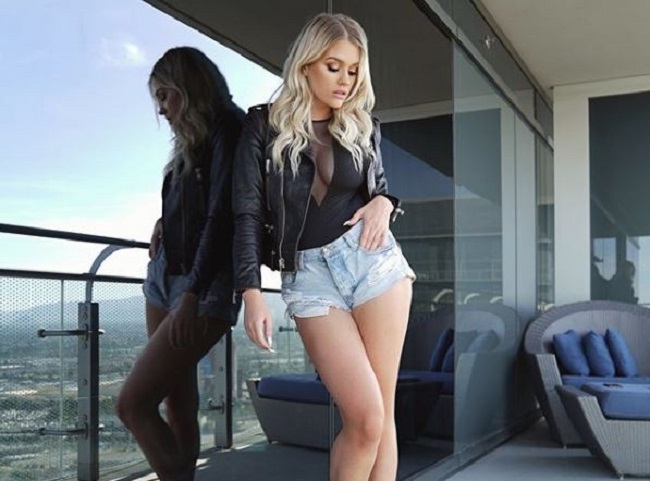They have hundreds of thousands, sometimes millions of followers on social media.

But they aren’t famous actors or pro athletes. In fact, you may have never heard their names before.
LISTEN: Under the influence: inside the ‘Wild West’ of social media ‘influencer’ marketing
They are a growing group of so-called “influencers,” social media personalities making big bucks posting to their Instagram, Twitter and YouTube accounts.
And they’re the face of what some believe is a new age of marketing and others describe as the “Wild West.”
The influencer
Samantha Ravndahl’s nine-to-five job is creating online content. She shares different beauty looks and tips on her Instagram, YouTube and Twitter accounts — and at times, gets paid to do it.
Between her YouTube and Instagram accounts, she has three million online followers.
To put that in perspective, she has more followers on Instagram than Prime Minister Justin Trudeau.
With more than three million followers, Samantha Ravndahl could be B.C.’s top social media influencer
So how did this become a career?
Ravndahl said she saw the trend emerging in 2012, not long after completing a nine-month makeup artistry program in Vancouver.
At the time, she was only using Instagram for fun, but that changed when she got fired from her job at a boutique makeup store.
“I just kind of noticed that all these people were starting to do social media and just spend a ton of time doing it,” she said.
“And I was like, ‘People must be getting paid, there’s no way that these people would be spending so much time doing this unless they were getting paid to do it.'”
She found out that brands would send products to people with blogs or a large online audience, who would then post about the products online if they liked them.
With 98,600 Instagram followers and 618,000 YouTube followers, Jennifer Chiu (@Chiutips), is among B.C.’s top social media influencers
Ravndahl saw a business opportunity and decided to travel south of the border to build business relationships — a strategy she said later paid off.
“I really tried to spend a lot of time, you know, just communicating with these brands and the paid work ended up naturally following,” she said.
“When these brands started, you know, adjusting their budgets to go towards social media, it was just kind of natural that they ended up reaching out and doing that.”
But the payday wasn’t instant. Ravndahl said it took about a year for her to begin to see consistent paid work. Every influencer has to develop their own business model, she said.
“You can make it through collaborations, you can make it through paid sponsorships, you can do it through promo codes,” she said.
“But anyone that’s doing it full-time, it’s not uncommon for them to be making over $100,000 a year. Some of the bigger people, some of like the top-tier people are making millions.”
With 56,000 Instagram followers, Kiara Schwartz (@tobruckave) is among B.C.’s top social media influencers
While that might seem excessive to some people, Ravndahl said the numbers are less eye-popping when looked at compared to traditional television advertising.

Get breaking National news
Under that model, she argues, marketing agencies pour millions of dollars into an ad campaign that may only appeal to one in four viewers in a particular household.
In influencer marketing, she said, it’s a different story.
“You have one person doing everything for you; they’re doing the makeup, they’re doing the hair, they’re doing the editing, they’re doing the photography, they’re conceptualizing the entire project from start to finish,” she said.
“The turnaround time is incredibly quick and then you’re basically guaranteeing that you are going to, like, 100 per cent your target demographic.”
Ravndahl now works with a manager, but said she resisted hiring one for several years over concerns about losing control of her personal brand and what products she was associated with.
“I don’t just take any job that comes my way,” she said. “I don’t want to promote something that I don’t use, and I don’t like and I don’t care about. I want to promote things that I genuinely enjoy because I have the option to.”
With 59,000 Instagram followers, Jennifer Hallet (@Jeylaloves) is one of B.C.’s top social media influencers
The marketing specialists
Jessica Thomas-Cooke runs INF, an influencer-specific management company she co-founded in 2013, and said people can succeed in the industry even without much experience or training.
That’s because what makes a good influencer, she said, is the fact that they are real, everyday people. As a result, she argues they’re easier to relate to than a traditional model.
“You know, when I flip through the pages of a magazine… they’re there to wear the clothes and they’re tiny and skinny and beautiful and they’re gonna look good. And I’m gonna go, ‘You know what, I’m never going to look like that,'” she said.
“But when I see someone that might have a body shape more like myself and I’m scrolling through Instagram, I go, ‘You know, I can see myself in that,’ because she looks like me, she’s just like me.”
With 45,000 Instagram followers, TV host Todd Talbot (@toddtalbot) is one of B.C.’s top social media influencers
Hilary Chan-Kent, a former public relations specialist, co-founded INF with Thomas-Cooke. She said her old role in PR allowed her to see how influencers were shaping culture and how advertising dollars were following.
“Brands were starting to realize that investing in these people who have this amazing built-in, loyal following — these content creators — was really getting their message across, so that was how we positioned ourselves,” she said.
“We were here to streamline the advertising and marketing dollars and help make it easier for the talent, which is what we call influencers, because the most hated part of their job was negotiating, creating contracts, doing invoices.”
According to Katie Reiach, co-founder of influencer-focused PR firm Talk Shop Media, there are strong business advantages for brands that work with influencers.
“You can hook into somebody’s YouTube channel and access millions and millions of followers and actually see the sort of path, right down to your analytics, and translate that into sales for your products or services,” she said.
She said the consumer trust generated by working with someone who actually likes and uses a brand’s product, combined with the method’s extremely narrow targeting, means a small ad buy can generate an outsize result.
With 119,000 Instagram followers, “Brie and Ruben” of @Vancitywild are among B.C.’s top social media influencers
But there are also challenges with this marketing phenomenon.
From Reiach’s perspective, brands that want to hire influencers need to approach the concept with a “buyer-beware” mentality.
“I would say half the people who are saying they don’t like followers bought have bought followers, so again, it’s the Wild West, who can you trust? How can you trust them?”
- ‘Cocaine lawyer’ for Ryan Wedding has legal licence suspended in Ontario
- Millions of dollars worth of fraud alleged to have happened at B.C. social development ministry
- Filipino BC defends funds distribution with former board members calling for transparency
- Surrey teen shot, killed by police was waving firearm, pointing it at officers: report
With more than 215,000 Instagram followers, Cara Mcleary (@carajourdan) is one among B.C.’s top social media influencers
https://www.instagram.com/p/BeFQoUOhRKs/?taken-by=carajourdan
For the time being, the technology doesn’t exist to easily parse the quality of an influencer’s follower base, Reiach said, meaning it’s important to meet them in real life and interact with them when deciding whether they’re a good fit.
She said it’s also important for brands to “try before they buy” and see what kind of actual results they get.
“And that’s where you know whose followers are real and whose are fake, because you see it,” she said. “You see the analytics on who’s actually leaving their page and going to your site and doing things like buying and engaging with your organization.”
With more than 164,000 Instagram followers, Monika Hibbs (@monikahibbs) is among B.C.’s top social media influencers
So how much money do influencers actually get paid? That ranges from city to city, Reiach said, with some influencers starting at about $2,500 per social media or blog post.
But she said she knows of one blogger from B.C. who posts about parenting, cooking, fashion tips and home decor who can bring in between $15,000 to $20,000 per post.
“I mean, that is somebody who is running a little empire. I don’t know the ins and outs of the financials of her business, but yeah, she’s made some smart decisions.”
Reiach believes influencer marketing will continue to grow, as consumers increasingly turn to faces they know and trust when making buying decisions. And she says it’s a two-way street, with influencers reacting to their audience.
“They do care what their followers are interested in, and they adapt their content and they really try and make it palatable in a way that people are, you know, enjoying and coming back.”
With more than 31,000 Instagram followers, Viranlly Liemena (@viranlly) is one of B.C.’s top social media influencers
https://www.instagram.com/p/BeBKZ21HVnL/
The regulators
But while the industry expands, how will those being targeted by this subtle marketing be protected?
It’s now been more than a year since Advertising Standards Canada (ASC), the country’s industry-operated self-regulating body, identified what it calls a “grey area.”
READ MORE: Tips from top craft bloggers – work hard, keep it simple
“We rely on consumer complaints and when we received a couple of complaints about non-disclosure by bloggers or influencers, we sort of realized it didn’t really fit necessarily in any of the existing areas of the code,” said ASC vice president Janet Feasby.
With more than 20,000 Instagram followers and 243,000 YouTube followers, Ryan Cheng (@chengman) is among B.C.’s top social media influencers
https://www.instagram.com/p/BdrP2Mchqxd/
For example, Feasby said the typical method of disclosure is for the reviewer to put hashtag “sponsor,” “ad” or “partner” in their post.
She said if ASC receives complaints, they then ask the writer to update their post with those hashtags.
If they don’t comply, the complaint would be forwarded to Canada’s Competition Bureau, she said. As of January 2018, no such referrals have occurred.
Competition Bureau deputy commissioner Josephine Palumbo said the agency has launched a Consumer Alert initiative to provide the public and businesses with information to protect themselves against misleading advertising.
With more than 150,000 Instagram followers, Maurice Li (@maurice) is one of B.C.’s top social media influencers
But in the end, she said, it is up to consumers to do their research.
“If it sounds too good to be true, it probably is too good to be true.”
As for Ravndahl, she said she’s only had positive experiences when letting people know that her content is sponsored.
“Everyone’s super-supportive and super-lovely about it,” she said.
“And I think that the consumer, they just want to know. They want to know that they, you know, are being advertised to.”










Comments